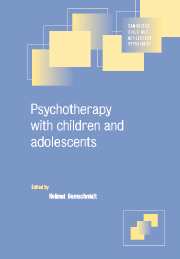Book contents
- Frontmatter
- Contents
- List of contributors
- Preface
- Part I Principles of psychotherapy with children, adolescents and families
- Part II Psychotherapeutic methods and settings
- Part III The practice of psychotherapy for specific disorders in childhood and adolescence
- 15 Anxiety disorders
- 16 Obsessive-compulsive disorder
- 17 Depressive syndromes and suicide
- 18 Dissociative [conversion] disorders
- 19 Disorders of sexual development and sexual behaviour
- 20 Substance abuse and addiction
- 21 Eating disorders
- 22 Psychotherapy in chronic physical disorders
- 23 Enuresis and faecal soiling
- 24 Dyslexia and dyscalculia
- 25 Stuttering
- 26 Hyperkinetic disorders
- 27 Autism
- 28 Schizophrenia
- 29 Conduct disorders, antisocial behaviour, delinquency
- 30 Physical abuse and neglect
- 31 Sexual abuse and sexual maltreatment
- Part IV The practice of psychotherapy in various settings
- Index
25 - Stuttering
- Frontmatter
- Contents
- List of contributors
- Preface
- Part I Principles of psychotherapy with children, adolescents and families
- Part II Psychotherapeutic methods and settings
- Part III The practice of psychotherapy for specific disorders in childhood and adolescence
- 15 Anxiety disorders
- 16 Obsessive-compulsive disorder
- 17 Depressive syndromes and suicide
- 18 Dissociative [conversion] disorders
- 19 Disorders of sexual development and sexual behaviour
- 20 Substance abuse and addiction
- 21 Eating disorders
- 22 Psychotherapy in chronic physical disorders
- 23 Enuresis and faecal soiling
- 24 Dyslexia and dyscalculia
- 25 Stuttering
- 26 Hyperkinetic disorders
- 27 Autism
- 28 Schizophrenia
- 29 Conduct disorders, antisocial behaviour, delinquency
- 30 Physical abuse and neglect
- 31 Sexual abuse and sexual maltreatment
- Part IV The practice of psychotherapy in various settings
- Index
Summary
Introduction and characteristics of the disorder
Stuttering is a disturbance of the fluency of speech, usually occuring during communicational speech (Bohme, 1977). Symptomsmay be classified as clonic, tonic or tonoclonic. In clonic stuttering, the fluency of speech is interrupted by frequent repetitions (sounds, syllables, words), whereas in tonic stuttering, speech is interrupted by a prolongation of sounds, especially the initial sound of a word or the first sound of a new sentence.
In ICD-10 stuttering (F98.5) is defined as being ‘characterized by frequent repetition and prolongation of sounds or syllables or words, or by frequent hesitations or pauses, that disrupt the rhythmic flow of speech’ (WHO, 1992).
If the disorder persists, many children and adolescents develop additional symptoms, e.g. ocular movements resembling tics, grimacing, unintentional tongue movements which make speech difficult, tongue-clicking, grunting noises and shaking movements of the head and extremities.
Pathological stuttering must be distinguished from ‘developmental’ or ‘physiological’ stuttering, which may occur in many children 2–4 years old in the course of normal speech development (‘developmental dysfluency’). However, pathological stuttering usually evolves from this stage of development, so that prevention and treatment are important if symptoms occur at this stage. If symptoms indicate that stuttering may be developing, parents should always be advised about the treatment options (Miltenberger and Woods, 1998).
Regardless of whether stuttering is regarded as the result of a neurotic tendency or is itself the onset of a neurosis, many children who stutter develop secondary psychiatric symptoms. These symptoms are usually the result of damaged self-esteem, e.g. in kindergarten or at school.
- Type
- Chapter
- Information
- Psychotherapy with Children and Adolescents , pp. 428 - 437Publisher: Cambridge University PressPrint publication year: 2001



